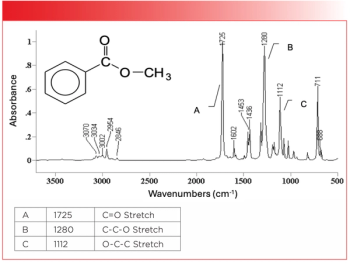
New Method for Detecting Fentanyl in Human Nails Using ATR FT-IR and Machine Learning
Key Takeaways
- Human nails are a promising alternative for detecting fentanyl exposure, offering a long-term record and uniform sample type unaffected by melanin or growth cycles.
- ATR FT-IR spectroscopy, combined with machine learning, achieved high accuracy in identifying fentanyl users, demonstrating its potential for forensic and toxicological screening.
Researchers have successfully demonstrated that human nails can serve as a reliable biological matrix for detecting fentanyl use. By combining attenuated total reflectance-Fourier transform infrared (ATR FT-IR) spectroscopy with machine learning, the study achieved over 80% accuracy in distinguishing fentanyl users from non-users. These findings highlight a promising, noninvasive method for toxicological and forensic analysis.
In a new study, scientists have shown that human nails can provide critical insights into past drug use, specifically for detecting fentanyl exposure. Traditionally, hair and bodily fluids have been the go-to biological samples for toxicological analysis. However, nails offer a compelling alternative due to their ability to retain foreign substances for extended periods. This study, conducted by Aubrey Barney, Václav Trojan, Radovan Hrib, Ashley Newland, Jan Halámek, and Lenka Halámková from Texas Tech University, St. Anne’s University Hospital Brno, and Masaryk University, utilized attenuated total reflectance-Fourier transform infrared (ATR FT-IR) spectroscopy combined with machine learning (ML) techniques to differentiate between individuals who had used fentanyl and those who had not (1). The results not only validate the efficacy of this approach but also demonstrate a new method for advancements in forensic toxicology. ATR FT-IR has great potential for non-destructive analysis of complex samples without sample preparation and in a dry state (1,2)
Fentanyl and the Need for Advanced Detection Methods
Fentanyl, a synthetic opioid, has become a major public health concern due to its extreme potency and widespread illicit use. Detecting fentanyl exposure accurately is crucial for forensic investigations, medical diagnoses, and legal proceedings. Current methods, such as gas or liquid chromatography-mass spectrometry (GC/LC–MS), are highly effective but often require extensive sample preparation and costly instrumentation. ATR FT-IR spectroscopy presents a viable alternative due to its non-destructive nature, minimal sample preparation, and ease of use (1).
How ATR FT-IR Spectroscopy Works
ATR FT-IR spectroscopy measures the absorption of infrared light by a sample using the principle of attenuated total reflection, producing an absorbance spectrum indicating its molecular composition. In this study, researchers analyzed nail clippings from fentanyl users and non-users to identify spectral differences indicative of fentanyl or its metabolites. These spectra were then processed using two ML techniques: partial least squares discriminant analysis (PLS-DA) and support vector machine discriminant analysis (SVM-DA) (1).
Key Findings and Accuracy of the Models
The ML models demonstrated impressive classification accuracy. The PLS-DA model correctly identified fentanyl-containing samples with an overall accuracy of 84.8%, while the SVM-DA model achieved an accuracy of 81.4%. Notably, when analyzing data at the donor level, the models successfully identified all fentanyl users without error. These results highlight the potential of ATR FT-IR spectroscopy, combined with ML, as a useful tool for forensic and toxicological screening (1).
Why Human Nails are an Ideal Sample Matrix
Human nails offer several advantages over traditional biological samples. Unlike hair, nails are not affected by melanin content or growth cycles, making them a more uniform sample type. They also retain substances for an extended period—potentially up to a year—providing a long-term record of drug exposure. Furthermore, nail collection is simple, noninvasive, and does not require special storage conditions, making it highly practical for field applications (1).
Challenges and Future Research
While this study represents a significant step forward, there are remaining challenges to address. One limitation is the focus on fentanyl citrate, which may not fully capture the variability seen with fentanyl analogs commonly found in illicit drug markets. Future research aims to expand the dataset to include various fentanyl derivatives, enhancing the robustness of detection models. Additionally, refining machine learning algorithms could further improve accuracy and specificity (1).
This pioneering research demonstrates that ATR FT-IR spectroscopy, coupled with ML, is a viable method for detecting fentanyl use through human nail analysis. With its noninvasive nature, long detection window, and high accuracy, this approach holds promise for forensic investigations, workplace drug testing, and clinical toxicology. As research continues to refine and expand these methodologies, ATR FT-IR spectroscopy may become a standard tool for rapid and reliable drug screening. This study marks a pivotal advancement in toxicological analysis, potentially transforming how forensic and medical experts detect fentanyl exposure in individuals (1).
References
(1) Barney, A.; Trojan, V.; Hrib, R.; Newland, A.; Halámek, J.; Halámková, L. From Spectra to Signatures: Detecting Fentanyl in Human Nails with ATR–FTIR and Machine Learning. Sensors 2025, 25 (1), 227. DOI:
(2) Workman, Jr. J. ATR FT-IR: A New Vision on Protein Structure and Aggregation.Available at:
Newsletter
Get essential updates on the latest spectroscopy technologies, regulatory standards, and best practices—subscribe today to Spectroscopy.




